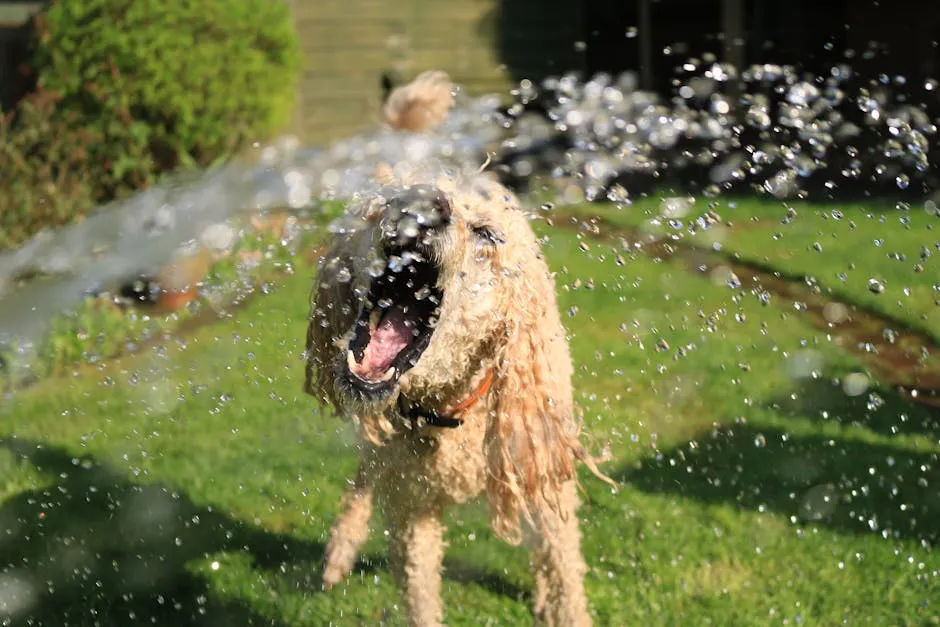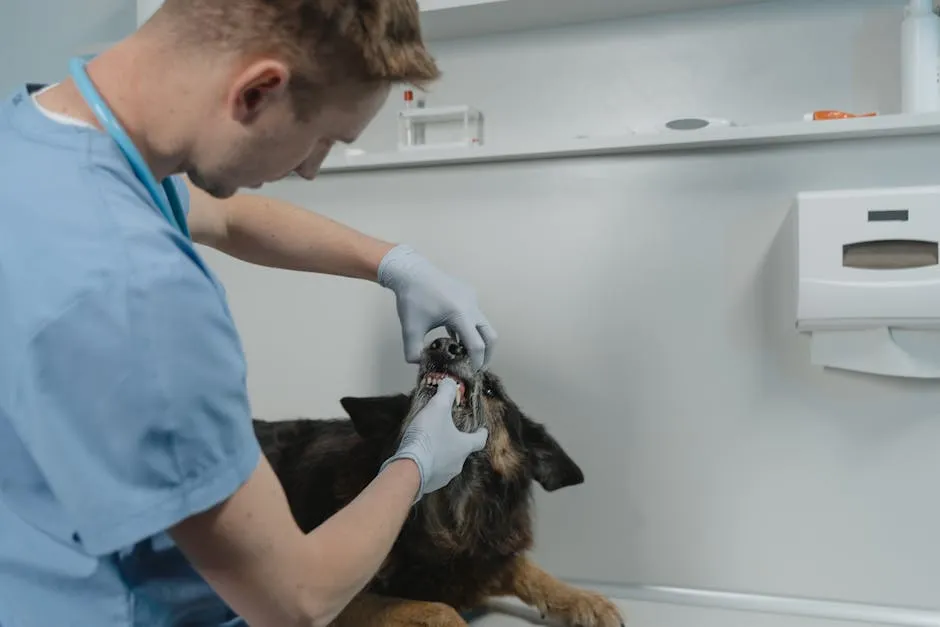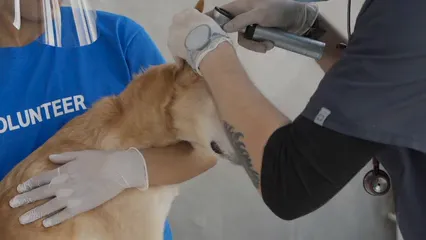
Conclusion
Understanding and preventing urinary tract health issues in dogs is essential for every pet owner. UTIs can affect any dog, leading to discomfort and potential complications if ignored. Key factors include maintaining a balanced diet, promoting hydration, and ensuring regular veterinary visits. Incorporating a diet rich in antioxidants and low in harmful minerals can significantly support your dog’s urinary health. Pay attention to symptoms and act promptly if you notice any changes in your dog’s behavior. Proactive care is vital. Routine check-ups and monitoring can catch issues before they escalate. So, keep your dog’s urinary tract in great shape by prioritizing a healthy diet and ensuring they receive proper veterinary care. Remember, a happy dog means a happy life! For those who want to pamper their pups, consider the PetFusion Ultimate Dog Bed. It’s perfect for providing your furry friend with the comfort they deserve.
FAQs
Can a dog get a UTI from holding its urine?
Prolonged holding can indeed contribute to UTIs. When dogs hold their urine too long, bacteria can multiply in the bladder, leading to infections. Encourage regular bathroom breaks to mitigate this risk.
What are the signs of a UTI at home?
Watch for signs like frequent urination, straining to urinate, blood in the urine, excessive licking of the genital area, and a foul-smelling urine. Changes in behavior, such as increased thirst or lethargy, may also indicate a UTI.
How can diet affect my dog’s urinary health?
Diet plays a significant role in urinary health. Foods that promote hydration and maintain an ideal urine pH can help prevent infections. Avoid high-ash or overly processed foods that can contribute to urinary issues.
Is it possible for a UTI to recur in dogs?
Yes, UTIs can recur, especially in predisposed breeds or dogs with underlying health conditions. Factors like poor hygiene, anatomical abnormalities, and diet can contribute to recurrence. Regular veterinary check-ups can help monitor and manage risks.
What should I do if I suspect my dog has a UTI?
If you suspect a UTI, contact your veterinarian promptly. Early diagnosis and treatment are vital for recovery. Bring any observed symptoms to your vet’s attention, and they may perform a urinalysis to confirm the diagnosis and recommend appropriate treatment.
Please let us know what you think about our content by leaving a comment down below!
Thank you for reading till here 🙂
All images from Pexels
Keeping an eye on your dog’s urinary health at home is a smart move. Start by monitoring their water intake. Is Fido drinking enough? Dehydration can lead to concentrated urine, increasing the risk of infections. You can also test their urine pH using simple test strips available online or at pet stores. Ideal urine pH for dogs generally falls between 6.5 and 7.0. Additionally, watch for signs of distress, like straining to urinate or excessive licking. If you notice anything unusual, don’t hesitate to contact your veterinarian. To help with the monitoring, consider using a Dog Water Bottle with Bowl. This handy tool ensures your dog stays hydrated on the go!
Hygiene Practices
Hygiene plays a vital role in preventing urinary tract infections, especially for female dogs. Cleanliness is next to dogliness! Ensure that your furry friend’s genital area stays clean and dry. For breeds with longer fur, regular grooming can help prevent infections. Also, encourage your pet to urinate regularly. Holding it in can create a perfect storm for bacterial growth. A well-maintained dog is a happy dog!Environmental Considerations
Creating a comfortable environment can significantly impact your dog’s urinary health. Make sure they have easy access to fresh water at all times. Hydration is key in flushing out the urinary system. Additionally, provide ample opportunities for bathroom breaks. If your dog is reluctant to go outside, consider adding a cozy blanket or a favorite toy near their designated potty area. A happy, relaxed dog is more likely to maintain good urinary habits.
Treatment Options for Canine UTIs
Antibiotics and Pain Relief
When it comes to treating urinary tract infections, antibiotics are typically the go-to solution. Your veterinarian will prescribe a course tailored to your dog’s specific needs. It’s crucial to follow the prescribed regimen and complete the course, even if symptoms improve. Stopping early can lead to stubborn bacteria that just won’t quit! Alongside antibiotics, your vet may recommend pain relief to help ease any discomfort. Keep an eye out for possible side effects, and always consult your vet if something seems off. A little TLC goes a long way in helping your furry friend recover.Dietary Adjustments During Treatment
When your dog faces a urinary tract infection (UTI), dietary adjustments can aid recovery. A proper diet can help reduce inflammation and support the healing process. First, ensure your dog stays well-hydrated. Increased water intake helps dilute the urine, flushing out harmful bacteria. Incorporating wet food or adding water to dry kibble can boost hydration levels effectively. Consider a specialized diet high in fiber, as it can help promote urinary health. Foods rich in essential nutrients, like antioxidants and omega fatty acids, can support your dog’s immune system. Additionally, certain natural supplements, such as Cranberry Extract for Dogs by Pet Naturals or D-Mannose Powder for Dogs, may help prevent bacteria from sticking to the bladder wall, reducing infection recurrence. Avoid high-ash or overly processed foods during treatment. These can contribute to urinary issues and hinder recovery. Instead, focus on high-quality, balanced dog food that meets their specific dietary needs. Consulting your veterinarian about the best dietary options during treatment ensures your furry friend gets the support they need.
Follow-up Care
Follow-up care is crucial for dogs recovering from UTIs. After completing the prescribed treatment, schedule a follow-up appointment with your veterinarian. This visit often includes a urinalysis to ensure the infection has cleared. Regular monitoring is vital, especially for dogs prone to recurrent infections. Your vet may recommend additional tests if symptoms persist or reappear. Being proactive helps catch any potential issues early on. This vigilance can save your dog from discomfort and serious complications. Plus, it’s an excellent opportunity to discuss any dietary adjustments or lifestyle changes to enhance your dog’s urinary health moving forward. To help with recovery, consider adding a Dog First Aid Kit by PetSafe to ensure you’re prepared for any unexpected situations.
Conclusion
Understanding and preventing urinary tract health issues in dogs is essential for every pet owner. UTIs can affect any dog, leading to discomfort and potential complications if ignored. Key factors include maintaining a balanced diet, promoting hydration, and ensuring regular veterinary visits. Incorporating a diet rich in antioxidants and low in harmful minerals can significantly support your dog’s urinary health. Pay attention to symptoms and act promptly if you notice any changes in your dog’s behavior. Proactive care is vital. Routine check-ups and monitoring can catch issues before they escalate. So, keep your dog’s urinary tract in great shape by prioritizing a healthy diet and ensuring they receive proper veterinary care. Remember, a happy dog means a happy life! For those who want to pamper their pups, consider the PetFusion Ultimate Dog Bed. It’s perfect for providing your furry friend with the comfort they deserve.
FAQs
Please let us know what you think about our content by leaving a comment down below!
Thank you for reading till here 🙂
All images from Pexels
Several foods and supplements can help support your dog’s urinary health. Cranberries are a superstar in this realm, known for their ability to prevent bacteria from adhering to the bladder wall. D-Mannose, a natural sugar, also works wonders in this regard. Add these to your dog’s diet for an extra layer of protection against UTIs. Don’t forget about hydration! Wet food can significantly increase your dog’s water intake, which is essential for flushing out the urinary tract. Keeping your dog hydrated helps dilute the urine, reducing the chances of crystal formation. Incorporating high-moisture foods, such as fresh fruits and vegetables, can also help maintain urinary health. Consider adding ingredients like pumpkin, which is not only tasty but also rich in fiber and moisture. For an extra boost, try Vet’s Best Bladder Control Dog Supplement. This supplement can help maintain bladder health and prevent issues.
Preventative Dietary Strategies
Certain breeds are more prone to urinary issues, requiring specific dietary strategies. For at-risk breeds, consider a low magnesium and phosphorus diet. This approach can help reduce the likelihood of crystal and stone formation. Brands like Hill’s Prescription Diet and Royal Canin offer specialized formulas that cater to urinary health. If you prefer a plant-based option, look into vegan dog foods designed with urinary health in mind. These options often include ingredients that balance urine pH while providing essential nutrients. It’s essential to consult your veterinarian before making significant dietary changes. They can help tailor a plan that meets your dog’s unique needs, ensuring they stay healthy and happy. By maintaining an ideal urine pH, avoiding an unbalanced diet, incorporating beneficial foods, and adopting preventative dietary strategies, you can significantly enhance your dog’s urinary health.
Preventative Measures for Canine Urinary Health
Regular Veterinary Check-ups
Routine veterinary visits are essential for your dog’s urinary health. Think of it as a spa day for their insides! Regular check-ups allow for early detection of potential urinary issues. Your vet can perform a urinalysis to check for bacteria, crystals, or signs of infection. Just like we wouldn’t ignore a nagging pain, neither should you overlook any changes in your pup’s bathroom habits. Remember, an ounce of prevention is worth a pound of cure!
Monitoring and Testing
Keeping an eye on your dog’s urinary health at home is a smart move. Start by monitoring their water intake. Is Fido drinking enough? Dehydration can lead to concentrated urine, increasing the risk of infections. You can also test their urine pH using simple test strips available online or at pet stores. Ideal urine pH for dogs generally falls between 6.5 and 7.0. Additionally, watch for signs of distress, like straining to urinate or excessive licking. If you notice anything unusual, don’t hesitate to contact your veterinarian. To help with the monitoring, consider using a Dog Water Bottle with Bowl. This handy tool ensures your dog stays hydrated on the go!
Hygiene Practices
Hygiene plays a vital role in preventing urinary tract infections, especially for female dogs. Cleanliness is next to dogliness! Ensure that your furry friend’s genital area stays clean and dry. For breeds with longer fur, regular grooming can help prevent infections. Also, encourage your pet to urinate regularly. Holding it in can create a perfect storm for bacterial growth. A well-maintained dog is a happy dog!Environmental Considerations
Creating a comfortable environment can significantly impact your dog’s urinary health. Make sure they have easy access to fresh water at all times. Hydration is key in flushing out the urinary system. Additionally, provide ample opportunities for bathroom breaks. If your dog is reluctant to go outside, consider adding a cozy blanket or a favorite toy near their designated potty area. A happy, relaxed dog is more likely to maintain good urinary habits.
Treatment Options for Canine UTIs
Antibiotics and Pain Relief
When it comes to treating urinary tract infections, antibiotics are typically the go-to solution. Your veterinarian will prescribe a course tailored to your dog’s specific needs. It’s crucial to follow the prescribed regimen and complete the course, even if symptoms improve. Stopping early can lead to stubborn bacteria that just won’t quit! Alongside antibiotics, your vet may recommend pain relief to help ease any discomfort. Keep an eye out for possible side effects, and always consult your vet if something seems off. A little TLC goes a long way in helping your furry friend recover.Dietary Adjustments During Treatment
When your dog faces a urinary tract infection (UTI), dietary adjustments can aid recovery. A proper diet can help reduce inflammation and support the healing process. First, ensure your dog stays well-hydrated. Increased water intake helps dilute the urine, flushing out harmful bacteria. Incorporating wet food or adding water to dry kibble can boost hydration levels effectively. Consider a specialized diet high in fiber, as it can help promote urinary health. Foods rich in essential nutrients, like antioxidants and omega fatty acids, can support your dog’s immune system. Additionally, certain natural supplements, such as Cranberry Extract for Dogs by Pet Naturals or D-Mannose Powder for Dogs, may help prevent bacteria from sticking to the bladder wall, reducing infection recurrence. Avoid high-ash or overly processed foods during treatment. These can contribute to urinary issues and hinder recovery. Instead, focus on high-quality, balanced dog food that meets their specific dietary needs. Consulting your veterinarian about the best dietary options during treatment ensures your furry friend gets the support they need.
Follow-up Care
Follow-up care is crucial for dogs recovering from UTIs. After completing the prescribed treatment, schedule a follow-up appointment with your veterinarian. This visit often includes a urinalysis to ensure the infection has cleared. Regular monitoring is vital, especially for dogs prone to recurrent infections. Your vet may recommend additional tests if symptoms persist or reappear. Being proactive helps catch any potential issues early on. This vigilance can save your dog from discomfort and serious complications. Plus, it’s an excellent opportunity to discuss any dietary adjustments or lifestyle changes to enhance your dog’s urinary health moving forward. To help with recovery, consider adding a Dog First Aid Kit by PetSafe to ensure you’re prepared for any unexpected situations.
Conclusion
Understanding and preventing urinary tract health issues in dogs is essential for every pet owner. UTIs can affect any dog, leading to discomfort and potential complications if ignored. Key factors include maintaining a balanced diet, promoting hydration, and ensuring regular veterinary visits. Incorporating a diet rich in antioxidants and low in harmful minerals can significantly support your dog’s urinary health. Pay attention to symptoms and act promptly if you notice any changes in your dog’s behavior. Proactive care is vital. Routine check-ups and monitoring can catch issues before they escalate. So, keep your dog’s urinary tract in great shape by prioritizing a healthy diet and ensuring they receive proper veterinary care. Remember, a happy dog means a happy life! For those who want to pamper their pups, consider the PetFusion Ultimate Dog Bed. It’s perfect for providing your furry friend with the comfort they deserve.
FAQs
Please let us know what you think about our content by leaving a comment down below!
Thank you for reading till here 🙂
All images from Pexels
Lifestyle choices significantly impact urinary health. Hydration is key. Dogs that don’t drink enough water can develop concentrated urine, creating a welcoming environment for bacteria. Make sure your furry friend has access to fresh water at all times. Hygiene is another critical factor. Regular baths and keeping the genital area clean can help prevent the buildup of bacteria. Also, ensure your dog has plenty of opportunities for bathroom breaks. Holding it in can lead to accidents and create an environment ripe for infections. Lastly, consider the cleanliness of your dog’s environment. Ensure their living spaces are tidy and free of waste to help keep urinary issues at bay. Small changes to your dog’s lifestyle can make a significant difference in their urinary tract health. To enhance hydration, consider using a PetSafe Drinkwell Platinum Pet Fountain. This fountain encourages dogs to drink more water, reducing the risk of urinary issues.
Diet’s Role in Urinary Health
Ideal Urine pH
Maintaining the right urine pH is vital for your dog’s urinary health. The ideal urine pH for dogs typically falls between 6.5 and 7.0. This slightly acidic range helps prevent the formation of struvite and calcium oxalate crystals, which can lead to urinary tract infections (UTIs) and other complications. When the pH strays too far from this range, it creates an environment conducive to bacterial growth. A balanced pH also aids in the proper functioning of the urinary system, ensuring that toxins are effectively expelled from the body. Regularly monitoring your dog’s urine pH can provide valuable insights into their health. If you notice significant fluctuations, consult your veterinarian for dietary adjustments or further evaluation.Dangers of an Unbalanced Diet
An unbalanced diet can wreak havoc on your pup’s urinary health. Diets that are overly acidic may promote the formation of calcium oxalate stones. On the flip side, overly alkaline diets can lead to struvite crystals. Both conditions are painful and can result in severe health issues if left untreated. Imagine your dog trying to pass painful stones while you watch helplessly! Preventing an unbalanced diet is crucial. It’s essential to provide a diet that meets your dog’s specific needs, ensuring it maintains an ideal urine pH. So, steer clear of feeding table scraps or high-ash pet foods. These can lead to imbalances that promote urinary issues. Instead, stick to high-quality dog food that’s specially formulated for urinary health. Consider options like Nature’s Logic Canine Chicken Meal Dinner Dog Food for optimal nutrition.
Foods to Promote Urinary Health
Several foods and supplements can help support your dog’s urinary health. Cranberries are a superstar in this realm, known for their ability to prevent bacteria from adhering to the bladder wall. D-Mannose, a natural sugar, also works wonders in this regard. Add these to your dog’s diet for an extra layer of protection against UTIs. Don’t forget about hydration! Wet food can significantly increase your dog’s water intake, which is essential for flushing out the urinary tract. Keeping your dog hydrated helps dilute the urine, reducing the chances of crystal formation. Incorporating high-moisture foods, such as fresh fruits and vegetables, can also help maintain urinary health. Consider adding ingredients like pumpkin, which is not only tasty but also rich in fiber and moisture. For an extra boost, try Vet’s Best Bladder Control Dog Supplement. This supplement can help maintain bladder health and prevent issues.
Preventative Dietary Strategies
Certain breeds are more prone to urinary issues, requiring specific dietary strategies. For at-risk breeds, consider a low magnesium and phosphorus diet. This approach can help reduce the likelihood of crystal and stone formation. Brands like Hill’s Prescription Diet and Royal Canin offer specialized formulas that cater to urinary health. If you prefer a plant-based option, look into vegan dog foods designed with urinary health in mind. These options often include ingredients that balance urine pH while providing essential nutrients. It’s essential to consult your veterinarian before making significant dietary changes. They can help tailor a plan that meets your dog’s unique needs, ensuring they stay healthy and happy. By maintaining an ideal urine pH, avoiding an unbalanced diet, incorporating beneficial foods, and adopting preventative dietary strategies, you can significantly enhance your dog’s urinary health.
Preventative Measures for Canine Urinary Health
Regular Veterinary Check-ups
Routine veterinary visits are essential for your dog’s urinary health. Think of it as a spa day for their insides! Regular check-ups allow for early detection of potential urinary issues. Your vet can perform a urinalysis to check for bacteria, crystals, or signs of infection. Just like we wouldn’t ignore a nagging pain, neither should you overlook any changes in your pup’s bathroom habits. Remember, an ounce of prevention is worth a pound of cure!
Monitoring and Testing
Keeping an eye on your dog’s urinary health at home is a smart move. Start by monitoring their water intake. Is Fido drinking enough? Dehydration can lead to concentrated urine, increasing the risk of infections. You can also test their urine pH using simple test strips available online or at pet stores. Ideal urine pH for dogs generally falls between 6.5 and 7.0. Additionally, watch for signs of distress, like straining to urinate or excessive licking. If you notice anything unusual, don’t hesitate to contact your veterinarian. To help with the monitoring, consider using a Dog Water Bottle with Bowl. This handy tool ensures your dog stays hydrated on the go!
Hygiene Practices
Hygiene plays a vital role in preventing urinary tract infections, especially for female dogs. Cleanliness is next to dogliness! Ensure that your furry friend’s genital area stays clean and dry. For breeds with longer fur, regular grooming can help prevent infections. Also, encourage your pet to urinate regularly. Holding it in can create a perfect storm for bacterial growth. A well-maintained dog is a happy dog!Environmental Considerations
Creating a comfortable environment can significantly impact your dog’s urinary health. Make sure they have easy access to fresh water at all times. Hydration is key in flushing out the urinary system. Additionally, provide ample opportunities for bathroom breaks. If your dog is reluctant to go outside, consider adding a cozy blanket or a favorite toy near their designated potty area. A happy, relaxed dog is more likely to maintain good urinary habits.
Treatment Options for Canine UTIs
Antibiotics and Pain Relief
When it comes to treating urinary tract infections, antibiotics are typically the go-to solution. Your veterinarian will prescribe a course tailored to your dog’s specific needs. It’s crucial to follow the prescribed regimen and complete the course, even if symptoms improve. Stopping early can lead to stubborn bacteria that just won’t quit! Alongside antibiotics, your vet may recommend pain relief to help ease any discomfort. Keep an eye out for possible side effects, and always consult your vet if something seems off. A little TLC goes a long way in helping your furry friend recover.Dietary Adjustments During Treatment
When your dog faces a urinary tract infection (UTI), dietary adjustments can aid recovery. A proper diet can help reduce inflammation and support the healing process. First, ensure your dog stays well-hydrated. Increased water intake helps dilute the urine, flushing out harmful bacteria. Incorporating wet food or adding water to dry kibble can boost hydration levels effectively. Consider a specialized diet high in fiber, as it can help promote urinary health. Foods rich in essential nutrients, like antioxidants and omega fatty acids, can support your dog’s immune system. Additionally, certain natural supplements, such as Cranberry Extract for Dogs by Pet Naturals or D-Mannose Powder for Dogs, may help prevent bacteria from sticking to the bladder wall, reducing infection recurrence. Avoid high-ash or overly processed foods during treatment. These can contribute to urinary issues and hinder recovery. Instead, focus on high-quality, balanced dog food that meets their specific dietary needs. Consulting your veterinarian about the best dietary options during treatment ensures your furry friend gets the support they need.
Follow-up Care
Follow-up care is crucial for dogs recovering from UTIs. After completing the prescribed treatment, schedule a follow-up appointment with your veterinarian. This visit often includes a urinalysis to ensure the infection has cleared. Regular monitoring is vital, especially for dogs prone to recurrent infections. Your vet may recommend additional tests if symptoms persist or reappear. Being proactive helps catch any potential issues early on. This vigilance can save your dog from discomfort and serious complications. Plus, it’s an excellent opportunity to discuss any dietary adjustments or lifestyle changes to enhance your dog’s urinary health moving forward. To help with recovery, consider adding a Dog First Aid Kit by PetSafe to ensure you’re prepared for any unexpected situations.
Conclusion
Understanding and preventing urinary tract health issues in dogs is essential for every pet owner. UTIs can affect any dog, leading to discomfort and potential complications if ignored. Key factors include maintaining a balanced diet, promoting hydration, and ensuring regular veterinary visits. Incorporating a diet rich in antioxidants and low in harmful minerals can significantly support your dog’s urinary health. Pay attention to symptoms and act promptly if you notice any changes in your dog’s behavior. Proactive care is vital. Routine check-ups and monitoring can catch issues before they escalate. So, keep your dog’s urinary tract in great shape by prioritizing a healthy diet and ensuring they receive proper veterinary care. Remember, a happy dog means a happy life! For those who want to pamper their pups, consider the PetFusion Ultimate Dog Bed. It’s perfect for providing your furry friend with the comfort they deserve.
FAQs
Please let us know what you think about our content by leaving a comment down below!
Thank you for reading till here 🙂
All images from Pexels
When it comes to urinary tract infections (UTIs) in dogs, not all breeds are created equal. Certain breeds are more prone to these pesky infections. For instance, Dalmatians and Bulldogs often top the list. Their unique anatomical structures can make them more susceptible to UTIs. But it’s not just breed that plays a role. Age matters, too. Older dogs tend to have weaker immune systems, making them prime targets for UTIs. Additionally, female dogs are at a higher risk. Their shorter urethras allow bacteria to travel more easily to the bladder. Hormonal changes, especially during heat cycles, can further increase their chances of developing infections. Underlying health conditions also add to the risk. Dogs with diabetes or Cushing’s disease, for example, may struggle to fend off bacteria. Immunocompromised pups are like open invitations for infections. So, if your dog falls into these categories, extra vigilance is essential. To support your dog’s urinary health, consider adding a high-quality diet to their routine. Brands like Hill’s Prescription Diet c/d Multicare Urinary Care Dry Dog Food and Royal Canin Urinary SO Dry Dog Food can help manage urinary health effectively.
Causes of Urinary Tract Infections
Bacterial Invasion
Bacteria are the main culprits behind UTIs in dogs. They typically enter the urinary tract through the urethra. Once inside, they can multiply and wreak havoc. Escherichia coli (E. coli) is the most common offender. This little troublemaker often hitches a ride from fecal matter. Other bacteria, like Staphylococcus and Klebsiella, can join the party, too. So how does this happen? Well, dogs may inadvertently expose themselves to bacteria by rolling in questionable substances or drinking from contaminated water. Regular grooming and hygiene can help minimize these risks.Underlying Health Conditions
Health issues can set the stage for UTIs. Conditions like diabetes make it tougher for dogs to ward off infections. High glucose levels in the urine create a buffet for bacteria! Similarly, Cushing’s disease weakens a dog’s immune system, increasing the likelihood of infections. Some anatomical anomalies can also contribute. For example, dogs with recessed vulvas or ectopic ureters may have a harder time flushing out bacteria. Knowing your dog’s health history can help you stay alert for potential issues.Lifestyle Factors
Lifestyle choices significantly impact urinary health. Hydration is key. Dogs that don’t drink enough water can develop concentrated urine, creating a welcoming environment for bacteria. Make sure your furry friend has access to fresh water at all times. Hygiene is another critical factor. Regular baths and keeping the genital area clean can help prevent the buildup of bacteria. Also, ensure your dog has plenty of opportunities for bathroom breaks. Holding it in can lead to accidents and create an environment ripe for infections. Lastly, consider the cleanliness of your dog’s environment. Ensure their living spaces are tidy and free of waste to help keep urinary issues at bay. Small changes to your dog’s lifestyle can make a significant difference in their urinary tract health. To enhance hydration, consider using a PetSafe Drinkwell Platinum Pet Fountain. This fountain encourages dogs to drink more water, reducing the risk of urinary issues.
Diet’s Role in Urinary Health
Ideal Urine pH
Maintaining the right urine pH is vital for your dog’s urinary health. The ideal urine pH for dogs typically falls between 6.5 and 7.0. This slightly acidic range helps prevent the formation of struvite and calcium oxalate crystals, which can lead to urinary tract infections (UTIs) and other complications. When the pH strays too far from this range, it creates an environment conducive to bacterial growth. A balanced pH also aids in the proper functioning of the urinary system, ensuring that toxins are effectively expelled from the body. Regularly monitoring your dog’s urine pH can provide valuable insights into their health. If you notice significant fluctuations, consult your veterinarian for dietary adjustments or further evaluation.Dangers of an Unbalanced Diet
An unbalanced diet can wreak havoc on your pup’s urinary health. Diets that are overly acidic may promote the formation of calcium oxalate stones. On the flip side, overly alkaline diets can lead to struvite crystals. Both conditions are painful and can result in severe health issues if left untreated. Imagine your dog trying to pass painful stones while you watch helplessly! Preventing an unbalanced diet is crucial. It’s essential to provide a diet that meets your dog’s specific needs, ensuring it maintains an ideal urine pH. So, steer clear of feeding table scraps or high-ash pet foods. These can lead to imbalances that promote urinary issues. Instead, stick to high-quality dog food that’s specially formulated for urinary health. Consider options like Nature’s Logic Canine Chicken Meal Dinner Dog Food for optimal nutrition.
Foods to Promote Urinary Health
Several foods and supplements can help support your dog’s urinary health. Cranberries are a superstar in this realm, known for their ability to prevent bacteria from adhering to the bladder wall. D-Mannose, a natural sugar, also works wonders in this regard. Add these to your dog’s diet for an extra layer of protection against UTIs. Don’t forget about hydration! Wet food can significantly increase your dog’s water intake, which is essential for flushing out the urinary tract. Keeping your dog hydrated helps dilute the urine, reducing the chances of crystal formation. Incorporating high-moisture foods, such as fresh fruits and vegetables, can also help maintain urinary health. Consider adding ingredients like pumpkin, which is not only tasty but also rich in fiber and moisture. For an extra boost, try Vet’s Best Bladder Control Dog Supplement. This supplement can help maintain bladder health and prevent issues.
Preventative Dietary Strategies
Certain breeds are more prone to urinary issues, requiring specific dietary strategies. For at-risk breeds, consider a low magnesium and phosphorus diet. This approach can help reduce the likelihood of crystal and stone formation. Brands like Hill’s Prescription Diet and Royal Canin offer specialized formulas that cater to urinary health. If you prefer a plant-based option, look into vegan dog foods designed with urinary health in mind. These options often include ingredients that balance urine pH while providing essential nutrients. It’s essential to consult your veterinarian before making significant dietary changes. They can help tailor a plan that meets your dog’s unique needs, ensuring they stay healthy and happy. By maintaining an ideal urine pH, avoiding an unbalanced diet, incorporating beneficial foods, and adopting preventative dietary strategies, you can significantly enhance your dog’s urinary health.
Preventative Measures for Canine Urinary Health
Regular Veterinary Check-ups
Routine veterinary visits are essential for your dog’s urinary health. Think of it as a spa day for their insides! Regular check-ups allow for early detection of potential urinary issues. Your vet can perform a urinalysis to check for bacteria, crystals, or signs of infection. Just like we wouldn’t ignore a nagging pain, neither should you overlook any changes in your pup’s bathroom habits. Remember, an ounce of prevention is worth a pound of cure!
Monitoring and Testing
Keeping an eye on your dog’s urinary health at home is a smart move. Start by monitoring their water intake. Is Fido drinking enough? Dehydration can lead to concentrated urine, increasing the risk of infections. You can also test their urine pH using simple test strips available online or at pet stores. Ideal urine pH for dogs generally falls between 6.5 and 7.0. Additionally, watch for signs of distress, like straining to urinate or excessive licking. If you notice anything unusual, don’t hesitate to contact your veterinarian. To help with the monitoring, consider using a Dog Water Bottle with Bowl. This handy tool ensures your dog stays hydrated on the go!
Hygiene Practices
Hygiene plays a vital role in preventing urinary tract infections, especially for female dogs. Cleanliness is next to dogliness! Ensure that your furry friend’s genital area stays clean and dry. For breeds with longer fur, regular grooming can help prevent infections. Also, encourage your pet to urinate regularly. Holding it in can create a perfect storm for bacterial growth. A well-maintained dog is a happy dog!Environmental Considerations
Creating a comfortable environment can significantly impact your dog’s urinary health. Make sure they have easy access to fresh water at all times. Hydration is key in flushing out the urinary system. Additionally, provide ample opportunities for bathroom breaks. If your dog is reluctant to go outside, consider adding a cozy blanket or a favorite toy near their designated potty area. A happy, relaxed dog is more likely to maintain good urinary habits.
Treatment Options for Canine UTIs
Antibiotics and Pain Relief
When it comes to treating urinary tract infections, antibiotics are typically the go-to solution. Your veterinarian will prescribe a course tailored to your dog’s specific needs. It’s crucial to follow the prescribed regimen and complete the course, even if symptoms improve. Stopping early can lead to stubborn bacteria that just won’t quit! Alongside antibiotics, your vet may recommend pain relief to help ease any discomfort. Keep an eye out for possible side effects, and always consult your vet if something seems off. A little TLC goes a long way in helping your furry friend recover.Dietary Adjustments During Treatment
When your dog faces a urinary tract infection (UTI), dietary adjustments can aid recovery. A proper diet can help reduce inflammation and support the healing process. First, ensure your dog stays well-hydrated. Increased water intake helps dilute the urine, flushing out harmful bacteria. Incorporating wet food or adding water to dry kibble can boost hydration levels effectively. Consider a specialized diet high in fiber, as it can help promote urinary health. Foods rich in essential nutrients, like antioxidants and omega fatty acids, can support your dog’s immune system. Additionally, certain natural supplements, such as Cranberry Extract for Dogs by Pet Naturals or D-Mannose Powder for Dogs, may help prevent bacteria from sticking to the bladder wall, reducing infection recurrence. Avoid high-ash or overly processed foods during treatment. These can contribute to urinary issues and hinder recovery. Instead, focus on high-quality, balanced dog food that meets their specific dietary needs. Consulting your veterinarian about the best dietary options during treatment ensures your furry friend gets the support they need.
Follow-up Care
Follow-up care is crucial for dogs recovering from UTIs. After completing the prescribed treatment, schedule a follow-up appointment with your veterinarian. This visit often includes a urinalysis to ensure the infection has cleared. Regular monitoring is vital, especially for dogs prone to recurrent infections. Your vet may recommend additional tests if symptoms persist or reappear. Being proactive helps catch any potential issues early on. This vigilance can save your dog from discomfort and serious complications. Plus, it’s an excellent opportunity to discuss any dietary adjustments or lifestyle changes to enhance your dog’s urinary health moving forward. To help with recovery, consider adding a Dog First Aid Kit by PetSafe to ensure you’re prepared for any unexpected situations.
Conclusion
Understanding and preventing urinary tract health issues in dogs is essential for every pet owner. UTIs can affect any dog, leading to discomfort and potential complications if ignored. Key factors include maintaining a balanced diet, promoting hydration, and ensuring regular veterinary visits. Incorporating a diet rich in antioxidants and low in harmful minerals can significantly support your dog’s urinary health. Pay attention to symptoms and act promptly if you notice any changes in your dog’s behavior. Proactive care is vital. Routine check-ups and monitoring can catch issues before they escalate. So, keep your dog’s urinary tract in great shape by prioritizing a healthy diet and ensuring they receive proper veterinary care. Remember, a happy dog means a happy life! For those who want to pamper their pups, consider the PetFusion Ultimate Dog Bed. It’s perfect for providing your furry friend with the comfort they deserve.
FAQs
Please let us know what you think about our content by leaving a comment down below!
Thank you for reading till here 🙂
All images from Pexels
Introduction
Understanding canine urinary tract health is crucial for every dog owner. Just like humans, dogs can suffer from urinary tract infections (UTIs). These pesky infections can be quite common among our furry friends. In fact, studies show that around 14% of dogs will experience at least one UTI in their lifetime. If left untreated, UTIs can lead to severe complications, including kidney infections or even bladder stones. Yikes! We definitely want to avoid that. So, what’s the goal of this article? Well, we aim to provide you with comprehensive insights into canine urinary health. We’ll dive into effective prevention strategies and discuss dietary considerations that can help keep your pup’s urinary tract in tip-top shape. After all, a happy dog means a happy owner, right? Let’s get started on this journey to better urinary health for our beloved pets!
Understanding Urinary Tract Infections in Dogs
What is a UTI in Dogs?
A urinary tract infection (UTI) in dogs occurs when harmful bacteria invade the urinary system. The urinary tract includes several parts: the kidneys, bladder, ureters, and urethra. UTIs often begin when bacteria enter through the urethra and can travel up to the bladder, causing inflammation and discomfort. If the infection is not treated, it can ascend to the kidneys, leading to more serious conditions, such as pyelonephritis. Common causes of UTIs include bacterial invasion, immune deficiencies, and anatomical abnormalities. Factors like prolonged exposure to moisture or poor hygiene can also contribute to this pesky issue. Keep in mind that certain dog breeds, like Dalmatians and Bulldogs, may be more prone to UTIs due to their unique anatomical structures.Symptoms of UTIs in Dogs
Recognizing the symptoms of a UTI is key to ensuring your dog’s well-being. Common signs include:- Frequent urination or attempts to urinate
- Straining or pain while urinating
- Blood in the urine
- Licking around the urinary opening excessively
- Foul-smelling urine
- Increased thirst
- Lethargy or changes in behavior
Risk Factors and Predisposed Breeds
When it comes to urinary tract infections (UTIs) in dogs, not all breeds are created equal. Certain breeds are more prone to these pesky infections. For instance, Dalmatians and Bulldogs often top the list. Their unique anatomical structures can make them more susceptible to UTIs. But it’s not just breed that plays a role. Age matters, too. Older dogs tend to have weaker immune systems, making them prime targets for UTIs. Additionally, female dogs are at a higher risk. Their shorter urethras allow bacteria to travel more easily to the bladder. Hormonal changes, especially during heat cycles, can further increase their chances of developing infections. Underlying health conditions also add to the risk. Dogs with diabetes or Cushing’s disease, for example, may struggle to fend off bacteria. Immunocompromised pups are like open invitations for infections. So, if your dog falls into these categories, extra vigilance is essential. To support your dog’s urinary health, consider adding a high-quality diet to their routine. Brands like Hill’s Prescription Diet c/d Multicare Urinary Care Dry Dog Food and Royal Canin Urinary SO Dry Dog Food can help manage urinary health effectively.
Causes of Urinary Tract Infections
Bacterial Invasion
Bacteria are the main culprits behind UTIs in dogs. They typically enter the urinary tract through the urethra. Once inside, they can multiply and wreak havoc. Escherichia coli (E. coli) is the most common offender. This little troublemaker often hitches a ride from fecal matter. Other bacteria, like Staphylococcus and Klebsiella, can join the party, too. So how does this happen? Well, dogs may inadvertently expose themselves to bacteria by rolling in questionable substances or drinking from contaminated water. Regular grooming and hygiene can help minimize these risks.Underlying Health Conditions
Health issues can set the stage for UTIs. Conditions like diabetes make it tougher for dogs to ward off infections. High glucose levels in the urine create a buffet for bacteria! Similarly, Cushing’s disease weakens a dog’s immune system, increasing the likelihood of infections. Some anatomical anomalies can also contribute. For example, dogs with recessed vulvas or ectopic ureters may have a harder time flushing out bacteria. Knowing your dog’s health history can help you stay alert for potential issues.Lifestyle Factors
Lifestyle choices significantly impact urinary health. Hydration is key. Dogs that don’t drink enough water can develop concentrated urine, creating a welcoming environment for bacteria. Make sure your furry friend has access to fresh water at all times. Hygiene is another critical factor. Regular baths and keeping the genital area clean can help prevent the buildup of bacteria. Also, ensure your dog has plenty of opportunities for bathroom breaks. Holding it in can lead to accidents and create an environment ripe for infections. Lastly, consider the cleanliness of your dog’s environment. Ensure their living spaces are tidy and free of waste to help keep urinary issues at bay. Small changes to your dog’s lifestyle can make a significant difference in their urinary tract health. To enhance hydration, consider using a PetSafe Drinkwell Platinum Pet Fountain. This fountain encourages dogs to drink more water, reducing the risk of urinary issues.
Diet’s Role in Urinary Health
Ideal Urine pH
Maintaining the right urine pH is vital for your dog’s urinary health. The ideal urine pH for dogs typically falls between 6.5 and 7.0. This slightly acidic range helps prevent the formation of struvite and calcium oxalate crystals, which can lead to urinary tract infections (UTIs) and other complications. When the pH strays too far from this range, it creates an environment conducive to bacterial growth. A balanced pH also aids in the proper functioning of the urinary system, ensuring that toxins are effectively expelled from the body. Regularly monitoring your dog’s urine pH can provide valuable insights into their health. If you notice significant fluctuations, consult your veterinarian for dietary adjustments or further evaluation.Dangers of an Unbalanced Diet
An unbalanced diet can wreak havoc on your pup’s urinary health. Diets that are overly acidic may promote the formation of calcium oxalate stones. On the flip side, overly alkaline diets can lead to struvite crystals. Both conditions are painful and can result in severe health issues if left untreated. Imagine your dog trying to pass painful stones while you watch helplessly! Preventing an unbalanced diet is crucial. It’s essential to provide a diet that meets your dog’s specific needs, ensuring it maintains an ideal urine pH. So, steer clear of feeding table scraps or high-ash pet foods. These can lead to imbalances that promote urinary issues. Instead, stick to high-quality dog food that’s specially formulated for urinary health. Consider options like Nature’s Logic Canine Chicken Meal Dinner Dog Food for optimal nutrition.
Foods to Promote Urinary Health
Several foods and supplements can help support your dog’s urinary health. Cranberries are a superstar in this realm, known for their ability to prevent bacteria from adhering to the bladder wall. D-Mannose, a natural sugar, also works wonders in this regard. Add these to your dog’s diet for an extra layer of protection against UTIs. Don’t forget about hydration! Wet food can significantly increase your dog’s water intake, which is essential for flushing out the urinary tract. Keeping your dog hydrated helps dilute the urine, reducing the chances of crystal formation. Incorporating high-moisture foods, such as fresh fruits and vegetables, can also help maintain urinary health. Consider adding ingredients like pumpkin, which is not only tasty but also rich in fiber and moisture. For an extra boost, try Vet’s Best Bladder Control Dog Supplement. This supplement can help maintain bladder health and prevent issues.
Preventative Dietary Strategies
Certain breeds are more prone to urinary issues, requiring specific dietary strategies. For at-risk breeds, consider a low magnesium and phosphorus diet. This approach can help reduce the likelihood of crystal and stone formation. Brands like Hill’s Prescription Diet and Royal Canin offer specialized formulas that cater to urinary health. If you prefer a plant-based option, look into vegan dog foods designed with urinary health in mind. These options often include ingredients that balance urine pH while providing essential nutrients. It’s essential to consult your veterinarian before making significant dietary changes. They can help tailor a plan that meets your dog’s unique needs, ensuring they stay healthy and happy. By maintaining an ideal urine pH, avoiding an unbalanced diet, incorporating beneficial foods, and adopting preventative dietary strategies, you can significantly enhance your dog’s urinary health.
Preventative Measures for Canine Urinary Health
Regular Veterinary Check-ups
Routine veterinary visits are essential for your dog’s urinary health. Think of it as a spa day for their insides! Regular check-ups allow for early detection of potential urinary issues. Your vet can perform a urinalysis to check for bacteria, crystals, or signs of infection. Just like we wouldn’t ignore a nagging pain, neither should you overlook any changes in your pup’s bathroom habits. Remember, an ounce of prevention is worth a pound of cure!
Monitoring and Testing
Keeping an eye on your dog’s urinary health at home is a smart move. Start by monitoring their water intake. Is Fido drinking enough? Dehydration can lead to concentrated urine, increasing the risk of infections. You can also test their urine pH using simple test strips available online or at pet stores. Ideal urine pH for dogs generally falls between 6.5 and 7.0. Additionally, watch for signs of distress, like straining to urinate or excessive licking. If you notice anything unusual, don’t hesitate to contact your veterinarian. To help with the monitoring, consider using a Dog Water Bottle with Bowl. This handy tool ensures your dog stays hydrated on the go!
Hygiene Practices
Hygiene plays a vital role in preventing urinary tract infections, especially for female dogs. Cleanliness is next to dogliness! Ensure that your furry friend’s genital area stays clean and dry. For breeds with longer fur, regular grooming can help prevent infections. Also, encourage your pet to urinate regularly. Holding it in can create a perfect storm for bacterial growth. A well-maintained dog is a happy dog!Environmental Considerations
Creating a comfortable environment can significantly impact your dog’s urinary health. Make sure they have easy access to fresh water at all times. Hydration is key in flushing out the urinary system. Additionally, provide ample opportunities for bathroom breaks. If your dog is reluctant to go outside, consider adding a cozy blanket or a favorite toy near their designated potty area. A happy, relaxed dog is more likely to maintain good urinary habits.
Treatment Options for Canine UTIs
Antibiotics and Pain Relief
When it comes to treating urinary tract infections, antibiotics are typically the go-to solution. Your veterinarian will prescribe a course tailored to your dog’s specific needs. It’s crucial to follow the prescribed regimen and complete the course, even if symptoms improve. Stopping early can lead to stubborn bacteria that just won’t quit! Alongside antibiotics, your vet may recommend pain relief to help ease any discomfort. Keep an eye out for possible side effects, and always consult your vet if something seems off. A little TLC goes a long way in helping your furry friend recover.Dietary Adjustments During Treatment
When your dog faces a urinary tract infection (UTI), dietary adjustments can aid recovery. A proper diet can help reduce inflammation and support the healing process. First, ensure your dog stays well-hydrated. Increased water intake helps dilute the urine, flushing out harmful bacteria. Incorporating wet food or adding water to dry kibble can boost hydration levels effectively. Consider a specialized diet high in fiber, as it can help promote urinary health. Foods rich in essential nutrients, like antioxidants and omega fatty acids, can support your dog’s immune system. Additionally, certain natural supplements, such as Cranberry Extract for Dogs by Pet Naturals or D-Mannose Powder for Dogs, may help prevent bacteria from sticking to the bladder wall, reducing infection recurrence. Avoid high-ash or overly processed foods during treatment. These can contribute to urinary issues and hinder recovery. Instead, focus on high-quality, balanced dog food that meets their specific dietary needs. Consulting your veterinarian about the best dietary options during treatment ensures your furry friend gets the support they need.
Follow-up Care
Follow-up care is crucial for dogs recovering from UTIs. After completing the prescribed treatment, schedule a follow-up appointment with your veterinarian. This visit often includes a urinalysis to ensure the infection has cleared. Regular monitoring is vital, especially for dogs prone to recurrent infections. Your vet may recommend additional tests if symptoms persist or reappear. Being proactive helps catch any potential issues early on. This vigilance can save your dog from discomfort and serious complications. Plus, it’s an excellent opportunity to discuss any dietary adjustments or lifestyle changes to enhance your dog’s urinary health moving forward. To help with recovery, consider adding a Dog First Aid Kit by PetSafe to ensure you’re prepared for any unexpected situations.
Conclusion
Understanding and preventing urinary tract health issues in dogs is essential for every pet owner. UTIs can affect any dog, leading to discomfort and potential complications if ignored. Key factors include maintaining a balanced diet, promoting hydration, and ensuring regular veterinary visits. Incorporating a diet rich in antioxidants and low in harmful minerals can significantly support your dog’s urinary health. Pay attention to symptoms and act promptly if you notice any changes in your dog’s behavior. Proactive care is vital. Routine check-ups and monitoring can catch issues before they escalate. So, keep your dog’s urinary tract in great shape by prioritizing a healthy diet and ensuring they receive proper veterinary care. Remember, a happy dog means a happy life! For those who want to pamper their pups, consider the PetFusion Ultimate Dog Bed. It’s perfect for providing your furry friend with the comfort they deserve.
FAQs
Please let us know what you think about our content by leaving a comment down below!
Thank you for reading till here 🙂
All images from Pexels





